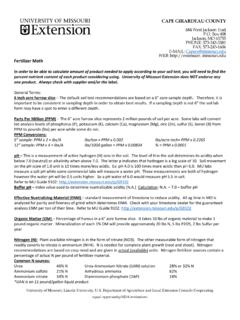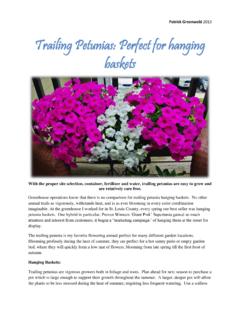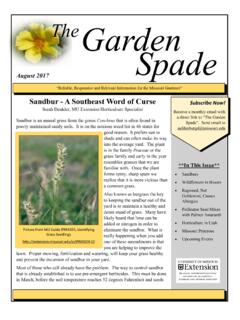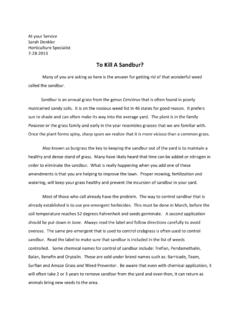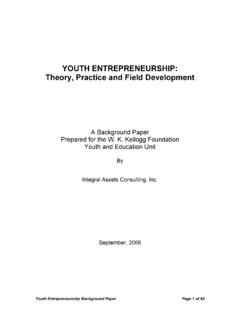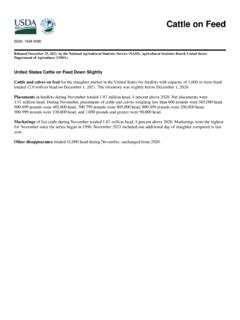Transcription of Custom Rates for Farm Services in Missouri
1 G302 Custom Rates for farm Services in MissouriThe Rates reported in this guide summarize a statewide survey conducted online and by solicitations of University of Missouri Extension specialists in the winter of 2019 2020. We asked farmers, agribusiness firms and land improvement contractors to provide the Rates they were charging or paying in 2019 for Custom Services , excluding the cost of materials being applied.
2 Thank you to those who provided information even if it was just for one activ it people respond to this survey every time it is taken every three years. There may be fewer farmers using Custom operators or fewer businesses conducting Custom activities. But it is still a very popular Extension guide. The number of responses to many questions asked was too low to have statistical confidence in the results. However, the results presented here have been compared to Custom Rates guides in Kansas and Iowa to see if our Rates are in line with their Rates .
3 These results have also been compared to previous Custom Rates surveys to see if the direction and magnitude of changes seems reasonable. Custom Rates cover the cost of machinery, fuel, labor and, occasionally, a product such as lime or bale wrap. The USDA reports that machinery values and labor costs have increased by about 5 percent and 11 percent, respectively, since our last Custom rate survey in 2016. Diesel prices have increased by 20 percent in the last three years. This increase in the costs of inputs into Custom activities suggest that Custom Rates should have increased over the past several years.
4 There is no assurance that the average Rates reported in this guide will cover your costs for performing the service or that you will be able to hire a Custom operator in your area for the Rates shown. Calculate your own costs carefully before deciding the rate to charge or pay. Before entering into an agreement, discuss with the other party all the details of the specific job to be of the Rates in this guideRates in this guide reflect each respondent s judgment of a normal job. Operators may add charges if they consider a job abnormal, such as distance from the operator s base location, the amount of product or labor involved, the difficulty of the terrain, or special requirements of the customer or Number reporting and Range in Rates columns are important.
5 The Average rate column indicates the average charge for all of the Rates in that row. The Mid rate had an equal number of responses higher and in past years, this guide reports the average rate, and the low, mid and high Rates reported by those providing responses. When few responses are averaged, a single response can move the average a lot. Because of the low response rate and the undue influence a single response may have on the average, this year two new columns are reported for all Custom activities: second lowest response and second highest response.
6 By comparing the two lowest and the two highest responses, users can see if perhaps the extreme responses were not representative of the next closest responses. In this situation, the extremes may have unduly influenced the average reported. The lowest and highest responses also give the user an idea of how variable the Rates charged for field activities might be. Possible explanations of the wide ranges are the type or size of equipment used, the mix of labor and equipment used, or different income needs of full time Custom operators compared to local farmers supplementing their byRay Massey, Extension Professor, Agricultural Business and Policypage 2g302 University of Missouri ExtensionTable 2.
7 Planting rateRange in ratesNumber reportingLowestSecond lowestMidSecond highestHighestConventional plantingCorn or grain sorghum: plant only$ / acre$ $ $ $ $ or grain sorghum: plant and apply fertilizer or / : plant 15- or 30-inch / : drill 7- or 9-inch / 017. 0 grains, grass or clover: / plantingCorn or grain sorghum: plant / or grain sorghum: plant and apply fertilizer or / : plant 15- or 30-inch / : drill 7- or 9-inch / grains, grass or clover: / 1. Field work rateRange in ratesNumber reportingLowestSecond lowestMidSecond highestHighestV-rip or subsoil plowing$ / acre$ $ $ $ $ / or offset / 5 06 Tandem / tillage / / brush (brush hog) / 08 Mow pasture or CRP / / 3g302 University of Missouri ExtensionTable 3.
8 Fertilizer and chemical rateRange in ratesNumber reportingLowestSecond lowestMidSecond highestHighestDeliver and spread fertilizer (not including the cost of fertilizer)Dry fertilizer on cropland: single spread$ / acre$ $ $ $ $ fertilizer on cropland: double / 0 fertilizer on cropland: variable / acre7. 0 fertilizer on pasture (topdressing) / 0 fertilizer plus / 0 liquid / liquid fertilizer and other / anhydrous / and spread: including / / chemicals (not including the cost of chemicals)Spray with self-propelled crop / 0 4.
9 Harvesting and hauling rateRange in ratesNumber reportingLowestSecond lowestMidSecond highestHighestCombiningCorn$ / acre$ $ $ $ $ / / / corn or grain sorghum silageField chop / ton7. 0 , haul and pile/fill / 06 Hauling grain or seedField to farm storage with farm vehicle or / bushel0 .100 .100 . to market with large grain truck over 20 / bushel0 . / loaded . livestockHauling livestock long distance with gooseneck trailer or farm / loaded 4g302 University of Missouri ExtensionTable 5. Harvesting and hauling rateRange in ratesNumber reportingLowestSecond lowestMidSecond highestHighestHay preparationCutting hay with disk cutter or sickle bar$ / acre$ $ $ $ 0$ and / acre7.
10 0 07. 5 / / baling only Small bales (750 1,000 lb.) / bales (1,000 1,500 lb.) / bales (1,500+ lb.) / , rake and baleSmall bales (750 1,000 lb.) / bales (1,000 1,500 lb.) / , rake, bale and net wrapSmall bales (750 1,000 lb.) / 017. 0 bales (1,000 1,500 lb.) / bales (1,500+ lb.) / and net wrapSmall bales (750 1,000 lb.) / bales (1,000 1,500 lb.) / bales (1,500+ lb.) / bale11. 0 hay activitiesSmall square baling only (50-100 lbs.) / individual round bale in plastic: including plastic / round bales on- farm or / 5g302 Revised 5/20page 5 Publications that are not going to be printed can have an odd number of pages.

